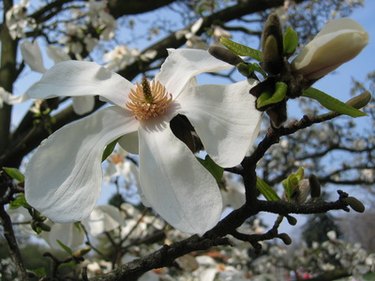
Magnolia trees are generally easy to care for. Most of the insects, diseases and fungal problems that the tree experiences are mild. However, sometimes these problems can take over the tree and cause serious damage. If serious problems occur, it is necessary to take additional steps to preserve the tree.
Straggly Branches
Video of the Day
The magnolia tree should be pruned about once a year to remove straggler branches that have grown at strange angles. Straggler branches do not damage the tree, but they can make the tree look unattractive. Prune these away in late winter or late summer. Prune the tree for shape as desired.
Video of the Day
Stunted Growth
Most varieties of magnolia trees are susceptible to frost. The tree should be protected in the winter by planting it in an area that is sheltered from harsh winds. Wrapping the trunk with insulation, such as burlap held in place with twine, is another way to protect the tree from frost. If the tree is frozen in the early spring, it may cause stunted growth for that year.
Droopy Leaves
Magnolia trees prefer dry conditions to wet conditions. If the tree's roots sit in water for extended periods, the leaves may start to droop. Too little watering, especially for young or newly transplanted trees, can also cause leaves to droop. Check the soil around the tree base. If it is saturated, water the tree less. If it shows cracks, then start watering more.
Bacterial Leaf Spot
Leaf spot is a bacterial disease that can affect magnolia trees. The infected leaves start with yellow or brown spots, which eventually cause leaves to fall. Infected leaves should be removed to prevent the spread of the disease. Do not cut the tree when sap is flowing and you'll reduce the number of bacteria that can enter the tree. Keep the tree fertilized in early spring to help the tree fight off fungal and bacterial infection.
Dieback
Dieback is defined as the death of a portion of the tree that was healthy in the past. Frosts too late in the season, insect infestations and poor soil quality can all cause dieback. Keep dieback at bay by fertilizing the magnolia tree each year with a fertilizer containing a large amount of nitrogen. If insects seem to be harming the tree, use an all-purpose insecticide on the leaves in the spring.
Powdery Mildew
Powdery mildew is a type of fungus that can attack magnolia leaves. If the infestation is on more than 1/3 of the leaves, use a copper fungicide spray to fight the fungus.
Yellow Leaves
If the magnolia tree's leaves are yellowed for no apparent reason, it is likely that the tree does not have enough nitrogen. Prevent this by fertilizing the tree each spring with a fertilizer that has a high nitrogen content.